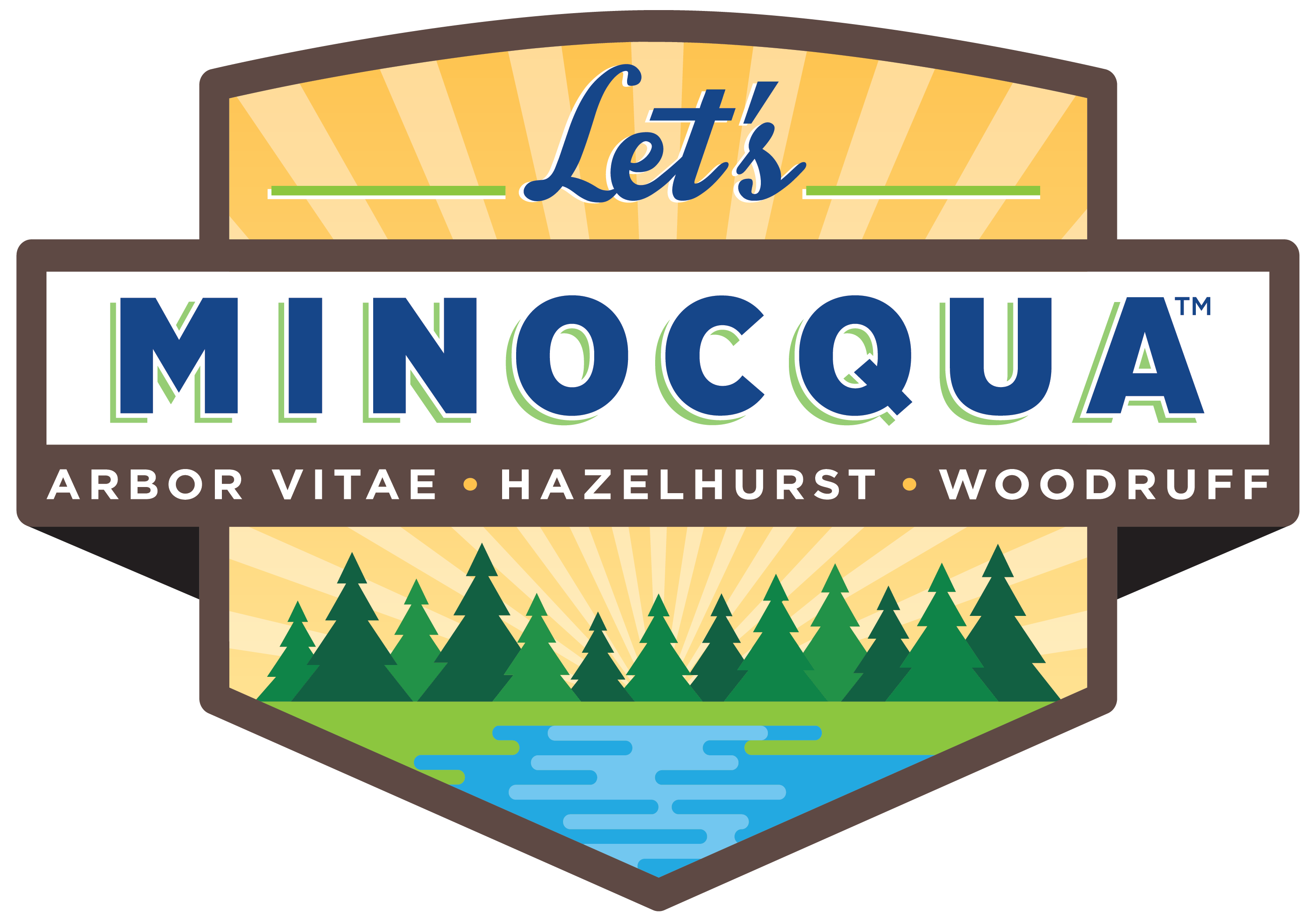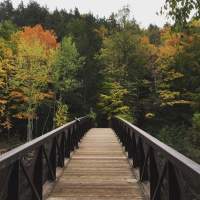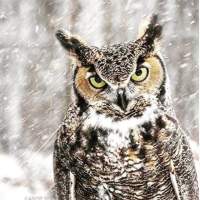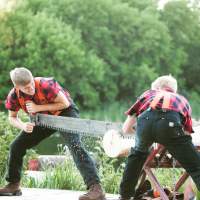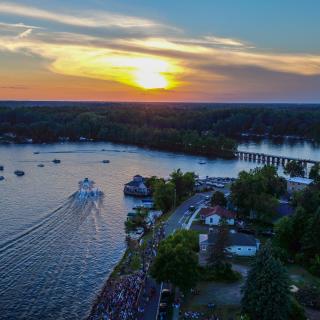Like a thread weaving through the fabric of Wisconsin’s Northwoods, the Bearskin State Trail lends color to the story of Minocqua. For more than 150 years, this area has drawn those seeking profit, adventure and recreation.
Today, the Bearskin is a recreational jewel that helps draw tens of thousands of visitors to the area each year. But the story begins millions of years ago, when glaciers gradually shaped this land. In a dance of procession and retreat, the glaciers left layers of “drift”, soil, rock and other organic debris, that helped form the region’s 2,300 lakes and streams, and its plentiful wetlands.
Much of the drift turned to sandy soil, ideal for the white pine that grew to cover the landscape as far as the eye could see. We come north today for the joy of being in a forest, but when European immigrants arrived in the 1800s, the dense pine forests were an impediment to settlement.
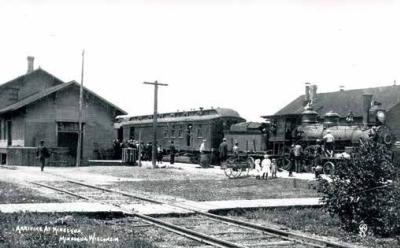
LOGGING CLEARS THE WAY
At the same time, a booming nation created a highly profitable market for building materials. In the late 1800s, a logging frenzy effectively clear-cut the vast forests. Logging, which essentially sold our forests down the river in the form of board feet, was an ecological disaster. Yet there were two outcomes that helped create the Northwoods we know today.
One was the creation, in 1925 and 1929, of the now combined Northern Highland and American Legion State Forests, a result of public awareness that forests were better nurtured than exploited. In 1933, the Nicolet and Chequamegon National Forests were created by presidential proclamation. Logging is still a part of Wisconsin’s economy, but forests are now managed for both timber production and recreation, both contributing to a thriving Northwoods.
RAILROADS PROVIDE ACCESS
The second outcome — railroad lines — is how we got the Bearskin Trail. The railroad was extended north by the Chicago, Milwaukee and St. Paul line to carry timber to urban hubs farther south. The forward-thinking rail company developed a thriving sideline to hauling lumber: carrying passengers. In January 1888, Train No. 13 began daily passenger service from Merrill to Minocqua, which wouldn’t officially become a town until a year later. Without the timber industry and the railroad, Minocqua might never have become the community we know today.
The train left Merrill at 7 a.m. daily, arriving in Minocqua at 12:05 p.m. Five hours to cover 50 miles might seem a tedious journey, but compared to foot or horseback, 10 miles an hour wasn’t bad. Visitors from farther south caught the No. 3 at New Lisbon at 5:25 a.m. and arrived in Minocqua at 11:59 a.m. Passengers from Milwaukee connected via the main Chicago, Milwaukee and St. Paul line. The summer journey took longer because summer passengers demanded frequent drop-offs at points where they would be met by horse-drawn wagons and transported to a lakeside resort. The resort industry was growing quickly, spurred by (relatively) easy access thanks to the railroad.
In 1919, the railway created “The Fisherman’s Special,” weekend service from Chicago to Minocqua, featuring nine pullman sleepers and two coach cars. A generally sold- out Fisherman’s Special left Chicago at 6:10 p.m. Friday, arriving in Minocqua at 6:45 a.m. on Saturday. On Sunday, happy anglers hopped aboard for a return trip that arrived in Chicago at 2 a.m. The Fisherman’s Special ran until 1948, suspending service from 1941 to 1946 when the government asked railroads to stop operations on recreational trains to conserve fuel and materials for the war. From 1936 to 1956, the North Woods Hiawatha offered a new level of luxury from Chicago. The new train, operating under a variety of names over the years, featured streamlined, air-conditioned cars and boasted a tap lounge, a dining-parlor car and a mail car.
Eventually, the development of highways and the popularity of automobiles took a toll on passenger rail service. As ticket purchases declined, passenger service was no longer profitable for the railroads. Their loss was our gain. The right-of-way from Heafford Junction to Minocqua was abandoned in late 1972. By November 26, 1973, the state had acquired the deed to the right-of-way that would become the Bearskin Trail. By 1977, improvements were complete — bridges and trestles had been planked and railed, and red granite laid to welcome hikers, bikers and snowmobilers.
The trail was completed at just over 18 miles in length, rising at a steady 3% grade (essentially flat) from the south trailhead (1,490 feet above sea level) to the north trailhead in Minocqua (1,600 feet above sea level). The only exception is the Pollnow Bypass. In some cases, the right of way reverted to the landowner instead of the state; that was the case with the Pollnow family, which declined to relinquish their legal right-of-way. The Pollnows prevailed in a court case, and the DNR sorted out a workaround thanks to the Owens-Illinois Paper Company. The result was a short but steep hill.
The railroad grade originally transformed into a recreational trail is 18.2 miles. Additional miles were added much later south of Highway K, giving outdoor enthusiasts a route of 26 miles from the Lincoln County line to Minocqua. That stretch includes some roadways, owing to gaps in state ownership. The Hiawatha Trail begins at the Lincoln County Line.
Heading north on the Bearskin from Highway K, it’s possible to bike or hike scenic stretches of 4-5 miles with no houses and no people except for the occasional fellow trail-user. Even at peak summer or autumn use, the Bearskin seldom feels crowded, except in the immediate Minocqua vicinity. A wayside with water, bathrooms and other amenities is situated midway between north and south trailheads, at Blue Lake.

CONSTRUCTION PROVES CHALLENGING
Building a rail line through the glaciated landscape of plentiful bogs proved problematic. The challenges of the undertaking are outlined in a series of descriptive markers along the trail. At Harshaw, the longest trestle of the bearskin (746 feet), a train derailed, plunging a steam locomotive and three cars into the bog. Two cranes were brought to the rescue and one of them also tipped off the tracks. To this day, the massive equipment lies at the bottom of the bog. They say if you poke a 20-foot steel rod into the bog, you’ll hit steel.
A more poignant incident occurred at a cattail marsh near the Kawaga Trestle, just south of Minocqua. The first two trestles sank into the marsh before they could even be completed. Subsequent efforts to lay a “corduroy” of 90-foot trees and fill it with sand ended in tragedy — the corduroy began sinking and the oxen and horses that were harnessed to transport the fill sand went down with it. Ninety feet below the surface lie 13 railroad sand cars, three teams of horses and six yoke of oxen.
Challenges in building the rail line caused at least one financial tragedy, as well. While the logging boom lined many pockets, it wasn’t so kind to Joseph Garland, who logged the island of Minocqua in the winter of 1886. He had
planned to ship lumber on the new rail line, but, thanks to the challenging landscape, that new line didn’t reach the island until the winter of 1887. Unable to get his logs to market, he went bankrupt.
A NATURAL TREASURE
Tragedies of the past, though, feel remote against the beauty of the trail. Mixed forests provide habitat for a variety of wildlife, including white-tailed deer, fox, bear, and many smaller critters. Wild animals are generally wary of humans and it takes a sharp eye to catch a glimpse of one. Easier to spot is an eagle soaring overhead; it’s not unusual to see several during an outing on the Bearskin. If you’re quiet, you may see turtles sunning on logs in the wetlands, and in the stretch along Blue Lake, loon calls are common. Wildflowers abound, especially in the spring, and the autumn color is spectacular, largely thanks to abundant tamarack.
The Bearskin is open to hiking and biking and is a popular snowmobile trail when Oneida County snowmobile trails are officially open. Cross-country skiing is also allowed, though the trail is not groomed for skiing. Horses are not allowed at any time of year, and a trail pass is required for bicyclists.
